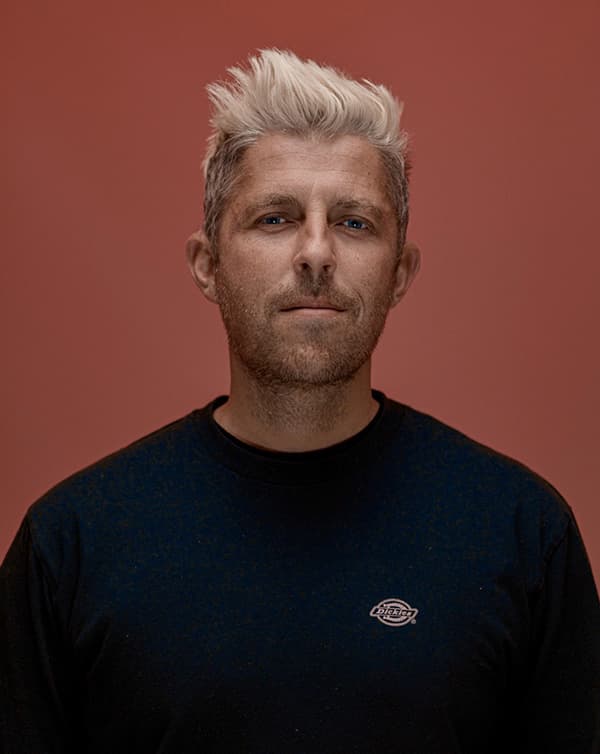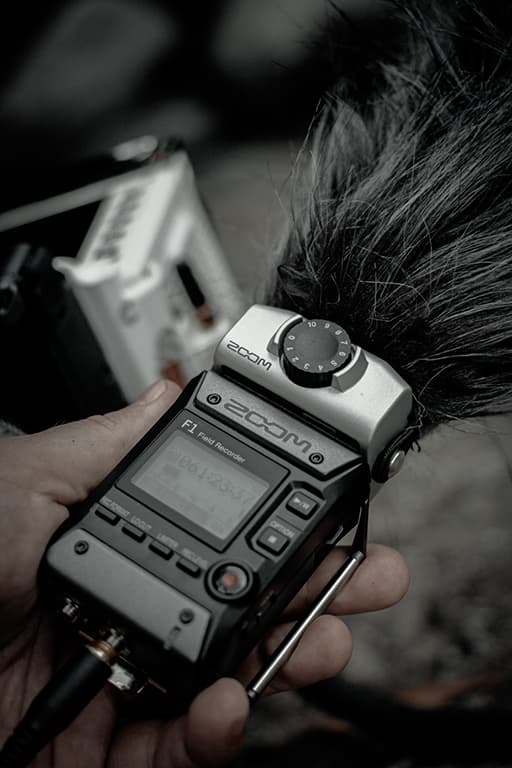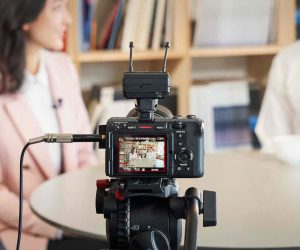
Life Through The Lens of Peter John
Glean insights from a globetrotting Aussie filmmaker with a passion for compelling music videos.

Peter John is a prolific Aussie filmmaker whose work is primarily in the music scene. Having produced music videos and documentaries for the likes of Bliss N Eso, The Paper Kites, Simple Plan and Planetshakers, his videos have garnered hundreds of millions of views thanks to Pete’s dedication to authentic storytelling and compelling visuals and audio.
AudioTechnology caught up with Peter John soon after he’d finished filming a documentary on tour with country artist Morgan Evans.
We chatted about the uniqueness of his work in the music scene, how to create content that cuts through the noise, the challenges and joys of being a traveling filmmaker, and the significance of creative audio in video production.
AT: Your direction and cinematography is mostly in the music scene?
PJ: Yeah. The other 2% of my work happens in the commercial world. My first music video was with a band called Antiskeptic in the year 2000 so it’s been over 20 years now, and 153 music videos.
AT: How do you plan a big concert shoot?
PJ: What I did on this tour for Morgan Evans was I brought crew in from different states for the different stadiums and they’d get the different angles. I tell them what shots I want, they dump it at the end, then I would bring it back and edit it all together. Typically we’d shoot multiple nights with the band wearing the same gear then we cut it together. It’s a bit of a sneaky way of doing a big thing on a smaller budget.
AT: Do you travel light?
PJ: I have two bags of gear; a backpack and a cabin bag. The last tour we went through Sydney, Melbourne, Brisbane, Ipswich, Newcastle, Auckland, Queenstown then Rainbow Beach on the Sunshine Coast, all with two bags.
AT: What’s in the bags?
PJ: My Red camera, a bunch of Zoom audio gear, black T-shirts and black pants. That’s pretty much it. I keep a minimal amount on me so it’s less stress day to day and then bring in the big stuff when needed.
AT: Shooting documentaries can mean you have a limited ability to control or script the end result. As a director and cinematographer how can you be prepared for anything?
PJ: Adaptability is key. There’s this Seth Godin quote I love where he said you can hold something so tight in your hand and work on it so much, but in a moment’s notice just let it go. That’s like getting all the emotional connection and intense thought process you’ve put into this idea, but instantly being able to let it go. If you’re able to do that you’re able to dominate anything. I reckon that’s one of the key secret weapons you can have as a storyteller or a filmmaker, to adapt quickly, knowing that concept is going to make what you’re making better.
AT: How do you know when’s the right time to let something go?
PJ: You need a deadline. If you don’t have a deadline you’ll always be trying to make it better. If you have a deadline you’ll only really do what you can do until that time. I think the only way I’ve been successful is because I’ve worked with artists who’ve already got their song release dates locked in so if the video doesn’t come at the right time they’re going to miss out on prime press. So even if I’m thinking ‘this is not finished yet’ I have no choice. And that push to a deadline is, I think, really the only reason I’ve been successful.

CREATIVE FLOW
AT: Do you ever find yourself in a creative rut?
PJ: I don’t think I’ve had that problem purely because everyone I work with is creative. I’ve had the pleasure of always having someone to bounce ideas off. I’m way better off when someone comes in with a little idea and I can build that into a big thing and then constrain it so it fits together cohesively. Most people have five ideas and they want to put it all into one video, that never works. I prefer getting one small idea and expanding it to make it big. That’s how I get my enthusiasm with creativity. And you’ve gotta always push yourself to do something new. That way your creativity stays fresh.
AT: What does a day on tour look like?
PJ: This latest Morgan Evans tour was one of the best I’ve been on. We had a whole bunch of great people; the band was unbelievably fun; everyone connected really well; and it was smaller, which I like because you can get more intimate and deep with everyone and find the story more easily. There’s less pressure to put on a persona. The average day on tour would be like: you wake up, find what time the lobby call is, get a coffee beforehand, probably do some stuff you should’ve done the night before, get out and go film some stuff – most days you’re filming some type of content, be it interviews or anything really. Then you go to the show and set up, which is a ‘hurry up and wait’ ordeal. You might do some behind the scenes backstage filming in the green room. Then the show’s on, you get the crew in, film the show, dump the footage for about an hour, pack up, get the bus back to the hotel, hopefully get more than five hours’ sleep, then wake up and do the same thing the next day.
AT: Do you edit as you go?
PJ: Yep. Sitting in a cafe, in a hotel lobby, in a hotel room, on a bus, on a plane – you’ve just gotta punch stuff up whenever you get the time. Everything’s fresh if you’re editing as you go and you can add more ideas and make the project better by understanding the depth of your content that’s already captured.



SUNTOWN STUDIOS
AT: How did Suntown Studios come about?
PJ: I got so bored during Covid that I decided I should do something constructive. There were a lot of creatives out there that have given up but are really so talented, that I felt they were needed more than ever especially when news and social media were telling you all the bad things about the world. Creatives are there to inspire us and give us hope. I thought if we’re not doing anything then this whole punishment of news and media is going to destroy us and I saw it happening locally and globally – it was terrible and I was compelled to something about it.
I always wanted to build a studio but I’d been travelling so much there wasn’t a point to it. So, my close mate Trentan Kruger and his wife Amy collaborated on building Suntown Studios for about a year – I said it was going to take three months. I wanted to use it for making my own content, doing music videos, making cool stuff for the local area but also bringing people in from interstate and across the world as well.
On top of that I wanted to be able to take the mentoring that I do to another level and offer high end training in filmmaking. That’s another thing that stopped during Covid and I really think there’s an importance to giving young guys some heads up. You see a lot of young crew do some cool stuff and then they fizzle out – I wanted to help get those people from having a some part time film work to making video as a full time job.
For me, it was a big jump around 2008 when I decided I’m only going to do music videos as a job. And I ate mi goreng noodles for six months until it started kicking off. There was a lot I learnt during those periods of my life and I want to help these younger crew do it because, not only is it important, but it gave me a dream life too. And there’s actually an industry for it now, which is begging for people to produce this type of high end content.
I reckon that’s one of the key secret weapons you can have as a storyteller or a filmmaker, to adapt quickly

LONGEVITY
AT: Has social media changed the way you think about producing video content?
PJ: I think it has changed but more that it’s made me double down on what I do. Video on Tik Tok and Instagram is all throwaway content, it’s literally just a whole lot of useless noise. People are relying on trends and algorithms to get views and hits to be successful. I understand it – you feel good when a lot of people are watching what you do. I come from a background where the longevity or impact of everything you do is the most important factor to your life. But now I’m seeing this massive shift to do content, content, content, but at the end of the day, for me, it’s just noise. That content won’t be remembered by the person who watched it in a week’s time or a day’s time. I double down on making stuff that people remember for a long time and it just keeps ticking over again and again. I’m not saying these platforms are terrible because they helped me at the start with my music videos going a bit viral, which helped my career. But it’s more the reason why you’re doing it. And I don’t think many people understand that. That comes a lot with the training that I do. People come in saying they really love making content and films and music but if you get swept into following the craze of the fads and trends you’ll end up losing your soul. You won’t keep doing it for the rest of your life, you’ll burn out and turn into someone you’ll most likely regret.
AT: What makes content memorable and gives it longevity?
PJ: It’s hard to put my finger on it but I’d start by saying ‘make something so good that people come to you.’ I don’t even know what that means – you can’t really bottle that concept up. But you have to connect, you have to be compelling, and you have to make people want to watch it again and make them feel something. When one of my first music videos for The Paper Kites (Bloom) went viral I didn’t realise what the storytelling and the look of it made people feel but when I started reading the comments, I got it. This is my job, I’m here to help people feel something and take them to a place better than where they’re at. Music does that for you. That different edge of creativity is the world I’m in. And I think there should be more of that, and less of the ‘throwaway’ content.


AUDIO CAPTURE
AT: What’s your approach to capturing audio?
PJ: They say audio is 51% of a film, it’s more important than the visual element. I make it my priority to utilise audio in ways no one really does, especially by adding layers of sound design in music videos. I spend a lot more time doing sound design editing than actually the video editing itself.
Hence why I take my Zoom stuff with me everywhere, so I can capture any sound anytime.
For example, I’m doing a music video for Morgan Evans at the moment and it’s him singing in a Sydney alleyway while it’s raining. So I might open it up with some ambient rain recordings that I grabbed on set and drop it in and out. Even during the Bliss N Esso doco, there’s a part where they creep out to the crowd and I follow them out to the stairs. I recorded and added footsteps on concrete and a door opening and shutting as they go through. Adding those extra layers of sound design really takes the viewer into another level of immersiveness.
AT: What’s your run ’n’ gun audio rig?
PJ: I record everything with the Zoom F1 recorder. I plug in the LMF-2 lapel mic for all the interviews I do – it sounds incredible. Then for recording ambient crowd noise and effects I use the SSH-6 shotgun capsule and XYH-5 mic. I find the F1 incredible. Being able to make adjustments easily and record on the device itself is great. I’ve used it so much in the last two weeks for the Morgan Evans documentary. My Zoom gear never breaks. I have a H4 that I’ve used for who knows how many years and it’s still running hot. I throw them in the most ridiculous places and they go hard. Plus I think the audio quality is impeccable.
AT: How do you use Zoom mics to capture ambience at a live concert?
PJ: I put two shotgun mics on stage as left and right and point them out towards the front crowd over the barrier. It gets the bigness of the crowd as well as the intimate sound of the people who are screaming or saying something in the front row. I try and use audio to get to that next dimension of quality so it’s not just the visuals that make you feel like you’re there but the audio plays a massive role in that too. When editing I tweak the audio master at the end and blend in some of my audio over the top just to get that extra live feeling. The Zoom shotguns sound so good that I’ve even been asked by the audio producers for the recordings to add underneath their live album mixes. This is my favourite part of the whole filmmaking process, just that little extra spice that makes the whole project spring to life.

























RESPONSES